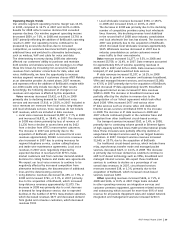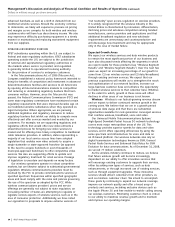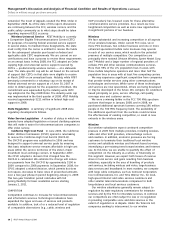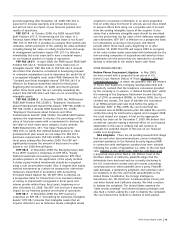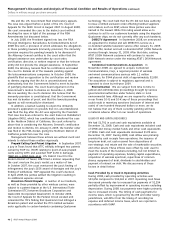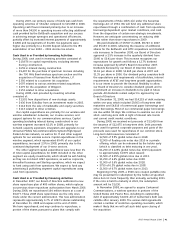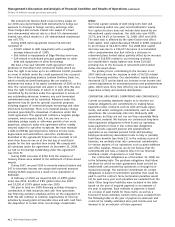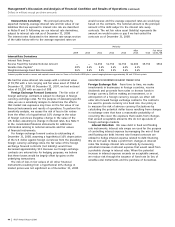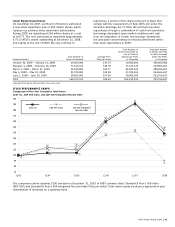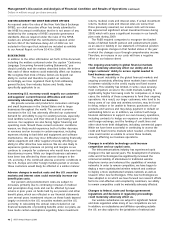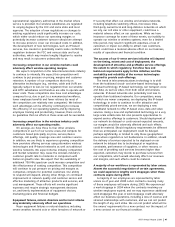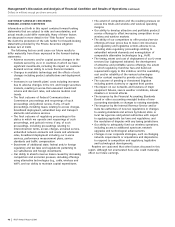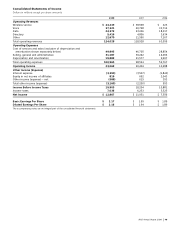AT&T Wireless 2008 Annual Report Download - page 41
Download and view the complete annual report
Please find page 41 of the 2008 AT&T Wireless annual report below. You can navigate through the pages in the report by either clicking on the pages listed below, or by using the keyword search tool below to find specific information within the annual report.
AT&T Annual Report 2008
| 39
periods beginning after November 15, 2008. FAS 161 is
expected to increase quarterly and annual disclosures
but will not have an impact on our financial position and
results of operations.
FSP 157-3 In October 2008, the FASB issued FASB
Staff Position 157-3, “Determining the Fair Value of a
Financial Asset When the Market of that Asset is not Active”
(FSP 157-3). FSP 157-3 provides an example that clarifies and
reiterates certain provisions of the existing fair value standard,
including basing fair value on orderly transactions and usage
of management and broker inputs. FSP 157-3 is effective
immediately but is not expected to have a material impact
on our financial position or results of operations.
FSP FAS 142-3 In April 2008, the FASB issued FASB Staff
Position FAS 142-3, “Determination of the Useful Life of
Intangible Assets” (FSP FAS 142-3). FSP FAS 142-3 amends
the factors that should be considered in developing renewal
or extension assumptions used to determine the useful life of
a recognized intangible asset under FASB Statement No. 142,
“Goodwill and Other Intangible Assets.” FSP FAS 142-3 is
effective for financial statements issued for fiscal years
beginning after December 15, 2008, and interim periods
within those fiscal years. We are currently evaluating the
impact that FSP FAS 142-3 will have on our accounting for
intangible assets.
FSP FAS 132(R)-1 In December 2008, the FASB issued
FASB Staff Position FAS 132(R)-1, “Employers’ Disclosures
about Postretirement Benefit Plan Assets” (FSP FAS 132(R)-1).
FSP FAS 132(R)-1 amends FASB Statement No. 132(R),
“Employers’ Disclosures about Pensions and Other
Postretirement Benefit” (FAS 132(R)). This FASB Staff Position
replaces the requirement to disclose the percentage of fair
value of total plan assets with a requirement to disclose the
fair value of each major asset category. It also amends
FASBStatement No. 157, “Fair Value Measurements”
(FAS157), to clarify that defined benefit pension or other
postretirement plan assets are not subject to FAS 157’s
disclosure requirements. FSPFAS132(R)-1 is effective for
fiscal years ending after December 2009. This FSP will
significantly increase the amount of disclosures for plan
assets in our 2009 Annual Report.
EITF 08-6 In November 2008, the Emerging Issues Task
Force (EITF) reached a consensus on EITF 08-6, “Equity
Method Investment Accounting Considerations.” EITF 08-6
provides guidance on the application of the equity method.
It states equity-method investments should be recognized
using a cost accumulation model. Also, it requires that equity
method investments as a whole be assessed for other-than-
temporary impairment in accordance with Accounting
Principles Board Opinion No. 18. EITF 08-6 is effective on
a prospective basis for transactions in an investee’s shares
occurring or impairments recognized in fiscal years, and
interim periods within those fiscal years, beginning on or
after December 15, 2008. This EITF will not have a material
impact on our financial position and results of operations.
EITF 08-7 In November 2008, the EITF reached a
consensus on EITF 08-7, “Accounting for Defensive Intangible
Assets.” EITF 08-7 provides that intangible assets that an
acquirer intends to use as defensive assets, intangible assets
acquired in a business combination or an asset acquisition
that an entity does not intend to actively use but does intend
to prevent others from using, are a separate unit of account
from the existing intangible assets of the acquirer. It also
states that a defensive intangible asset should be amortized
over the period that the fair value of the defensive intangible
asset diminishes. EITF 08-7 is effective on a prospective basis
for transactions occurring in fiscal years, and interim
periods within those fiscal years, beginning on or after
December 15, 2008. This EITF will require AT&T to recognize
at fair value certain assets associated with trademarks for the
non-surviving companies of acquisitions and amortize these
trademarks over the period they are expected to contribute
directly or indirectly to the entity’s future cash flows.
OT H ER BUSINE SS MATT E R S
Retiree Phone Concession Litigation In May 2005,
we were served with a purported class action in U.S.
District Court, Western District of Texas (Stoffels v. SBC
Communications Inc.), in which the plaintiffs, who are retirees
of Pacific Bell Telephone Company, Southwestern Bell and
Ameritech, contend that the telephone concession provided
by the company is, in essence, a “defined benefit plan” within
the meaning of the Employee Retirement Income Security
Act of 1974, as amended (ERISA). In October 2006, the Court
certified two classes. The issue of whether the concession
is an ERISA pension plan was tried before the judge in
November 2007. In May 2008, the court ruled that the
concession was an ERISA pension plan. We asked the court to
certify this ruling for interlocutory appeal and in August 2008,
the court denied our request. A trial on the appropriate
remedy has been set for December 7, 2009. We believe that
an adverse outcome having a material effect on our financial
statements in this case is unlikely, but will continue to
evaluate the potential impact of this suit on our financial
results as it progresses.
NSA Litigation There are 24 pending lawsuits that allege
that we and other telecommunications carriers unlawfully
provided assistance to the National Security Agency (NSA)
in connection with intelligence activities that were initiated
following the events of September 11, 2001. In the first filed
case, Hepting et al v. AT&T Corp., AT&T Inc. and Does 1-20,
a purported class action filed in U.S. District Court in the
Northern District of California, plaintiffs allege that the
defendants have disclosed and are currently disclosing to
the U.S. Government content and call records concerning
communications to which plaintiffs were a party. Plaintiffs
seek damages, a declaratory judgment, and injunctive relief
for violations of the First and Fourth Amendments to the
United States Constitution, the Foreign Intelligence
Surveillance Act, the Electronic Communications Privacy Act,
and other federal and California statutes. We filed a motion
to dismiss the complaint. The United States asserted the
“state secrets privilege” and related statutory privileges and
also filed a motion asking the court to dismiss the complaint.
The court denied the motions to dismiss of both parties.


